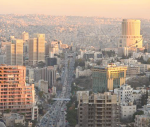You are here
Light pollution of artificial illumination
Oct 16,2023 - Last updated at Oct 16,2023
In our ever-illuminated modern world, the night sky is slowly vanishing, and the consequences of this light pollution are profound. We start with its inconvenience as it obscures the stars of the skies, particularly in our part of the world, where the majority of our nights are crystal clear. However, light pollution also disrupts ecosystems, affects human health, and obscures our connection to the cosmos impacting sustainability. In this article, we will discuss the causes, impacts, and potential solutions to the persisting issue of artificial light pollution.
The primary cause of light pollution is artificial lighting that includes streetlights, architectural lighting, vehicle lights, road lights and illuminated signs. These sources emit excess light into the night sky causing energy loss, potentially leading to sleep, psychological and physiological disorders. The expansion of urban areas leads to increased artificial lighting, exacerbating light pollution which disrupts the natural behaviours of various species, confuse and disorient them, particularly animals that rely on natural darkness for activities, such as foraging, mating, and navigation. Bats, owls, and insects are particularly vulnerable to light pollution, eventually affecting the bird population that feeds on them. It can interfere with hunting and feeding patterns, leading to reduced populations in affected areas, therefore creating an ecological imbalance which can disrupt local ecosystems and reduce biodiversity.
Artificial lighting suppresses the natural rhythm of our internal biological clock that regulates various behavioural processes in living organisms such as sleep-wake patterns and various psychological and physiological processes. Exposure to natural light, especially in the morning, helps synchronise this rhythm and promotes alertness during the day, enhances mood and cognitive ability, controls hormone production, regulates body temperature and supports a healthy sleep-wake cycle, which can improve the overall well-being of all members of the ecosystem. Therefore, spending a lot of time at home under artificial lighting is harmful to one`s health.
In our natural environment, many outdoor areas are over-illuminated, especially public buildings, as can be very well noticed in Amman, for example, with excessive and misdirected lighting that spreads beyond its intended area by negligence or ignorance. The proliferation of blue-rich LED lighting in streets and public spaces contributes to light pollution as it emits a higher proportion of blue light compared to traditional light sources. Blue light has a short wavelength and is known for its higher energy content and scatters more in the atmosphere, leading to greater light pollution and contributes to sky glow, making it more challenging to observe celestial objects. Blue light is also generated from artificial sources like smart phones and LED screens at night. To combat this, many cities are transitioning to less intrusive LED lighting and implementing smart lighting designs that reduce light pollution while maintaining safety and clearer visibility.
Artificial light pollution disrupts natural ecosystems and wildlife behaviour. Not only bats, owls, birds and insects are often disoriented by artificial lights, but also sea turtles. For example, sea turtles have a natural instinct to crawl towards the brightest horizon, which, in natural conditions, is the moonlit ocean. However, in areas with significant artificial coastal lighting, such as beachfront developments or streetlights, newly hatched turtles become disoriented. They may therefore head inland instead of towards the sea, where they become vulnerable to predation, dehydration, and exhaustion.
Light pollution has been associated with a higher risk of certain health issues, including obesity, type 2 diabetes, and even some cancers. This is often attributed to changes in melatonin levels (hormone), which can affect metabolism and appetite regulation. Pervasive artificial light can also impact mood and mental health, contributing to stress, anxiety and depression.
To avoid impacts of artificial lighting it is recommended to use improved lighting practices, such as encouraging the use of well-designed, fully shielded outdoor lighting fixtures that direct light downward and reduce light spill and scatter. It is also recommended to implement timers and motion sensors in outdoor lighting to ensure lights are only on when needed and to reach a good level of energy efficiency and reduced artificial lighting side effects.
Local governments can establish lighting regulations and zoning codes to limit light pollution in urban areas where biodiversity is threatened. Zoning codes can establish lighting curfews, or specifying the hours during which outdoor lighting should be dimmed or turned off completely. This helps reduce unnecessary light emission during nighttime hours. Codes can also mandate the use of fully shielded fixtures that direct light downward and minimise light spillage into the night sky, traffic and neighbouring dwellings, which can be noticed sometimes while driving when uncontrolled lighting hits you directly in the eyes.
Zoning regulations can set maximum allowable light levels for different types of areas (e.g., residential, commercial, industrial) to prevent over-illumination, scattering and glare. Some codes restrict the use of high-intensity, cool-coloured (blue-rich) LED lighting in favour of warmer, less disruptive colour temperatures. Warm colours are often associated with a more yellow or reddish look and are generally less intense and harsh on the eyes. Regulations can also govern the illumination of signs and billboards, ensuring they are well-lit without excessive light spillage and discomfort. For temporary events, zoning codes can establish guidelines for outdoor event lighting to minimise light pollution while allowing for safe and functional lighting during events, such as in weddings, Hajj and national celebrations.
In conclusion, it is important to raise public awareness about the importance of reducing artificial light pollution, engage communities and organisations in light pollution reduction efforts, choose lower colour temperature lighting that emits less blue light, implement smart street lighting systems that adjust brightness based on real-time needs, and reduce unnecessary illuminations. Thus, avoiding wide-ranging consequences for ecosystems and human health. Addressing this problem requires a multifaceted approach by taking action at the individual, community, and policy levels in order to reclaim our access to the natural night sky, reduce environmental disruption, and mitigate the harmful effects of light pollution for current and future generations of humans and wildlife.
Energy and green building consultant













